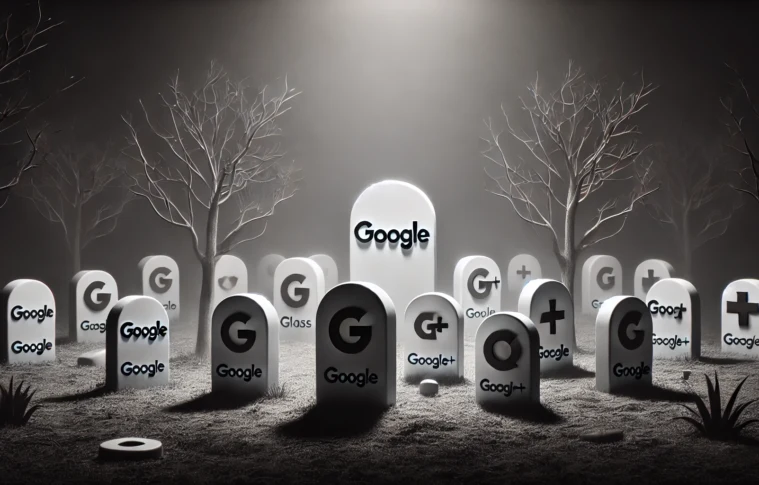Google, known for its innovative and widely successful products like Search, Gmail, and Android, has also seen its fair share of failures over the years. Despite the company’s successes, not every product has managed to resonate with users or stand the test of time. This blog explores some of Google’s most notable failed products, providing insights into why they were discontinued and what lessons can be learned.
1. Why Google Products Fail: Understanding the Causes
Google’s approach to product development is built on experimentation and rapid iteration. While this has led to groundbreaking successes, it has also resulted in a significant number of products being shelved. Some reasons for these failures include:
- Market Misalignment: Some products failed to find a sustainable user base or were launched in an oversaturated market.
- Internal Re-prioritization: Google often shifts its focus based on evolving strategic goals, leading it to shut down less critical projects.
- Competition: Some Google products faced stiff competition from already established players and failed to differentiate themselves.
- User Adoption: Certain innovations were ahead of their time or too complex for mainstream adoption.
Below, we look at some of Google’s most notable product failures, each offering a unique perspective on the complexities of innovation and product development.
2. Google+ (2011-2019): A Social Network That Never Took Off
Overview: Launched in 2011, Google+ was Google’s ambitious attempt to compete with Facebook by creating a social network with unique features like Circles and Hangouts. However, despite initial excitement, Google+ struggled to gain traction and was ultimately shut down in 2019.
Why It Failed:
- Low User Engagement: Google+ never attracted the kind of engaged, active user base that Facebook had.
- Privacy Concerns: In 2018, a data breach exposed the private information of nearly 500,000 users, further damaging its reputation.
- Competition: Established social networks like Facebook, Twitter, and Instagram dominated the space, leaving little room for a newcomer.
Lesson Learned: Timing and product-market fit are crucial in social media. Google+ didn’t offer enough differentiation to lure users away from established networks.
3. Google Wave (2009-2010): The Collaboration Tool Ahead of Its Time
Overview: Google Wave was an innovative collaboration platform designed to combine email, instant messaging, and document sharing. It aimed to revolutionize how people worked together online but was shuttered just a year after its launch due to low adoption.
Why It Failed:
- Complexity: The interface was challenging to navigate, making it difficult for users to understand its full functionality.
- Lack of User Understanding: Wave introduced too many new features at once, confusing users who were already comfortable with email and chat.
- Limited Target Audience: Wave’s advanced collaborative features appealed to a niche market, limiting its appeal to the broader public.
Lesson Learned: Innovation should be balanced with user-friendliness. Google Wave’s complexity alienated potential users, proving that usability is essential for adoption.
4. Google Glass (2013-2015): The Augmented Reality Pioneer That Fizzled Out
Overview: Google Glass was one of the most ambitious attempts at consumer-oriented augmented reality. The device was a pair of smart glasses equipped with a camera, display, and internet connectivity. It was primarily marketed toward tech enthusiasts and early adopters.
Why It Failed:
- Privacy Concerns: The device’s built-in camera raised significant privacy concerns, as users could record others without their consent.
- Design and Cost: Priced at $1,500, Glass was expensive and not particularly stylish or comfortable to wear.
- Limited Use Cases: Apart from the novelty, there weren’t enough practical applications for mainstream users.
Lesson Learned: Privacy and user design matter greatly, especially in wearable tech. Google Glass served as a lesson in balancing innovation with practical consumer appeal.
5. Google Buzz (2010-2011): The Short-Lived Social Network
Overview: Google Buzz was an early attempt at social networking built directly into Gmail. The idea was to let users share status updates, photos, and links with their contacts.
Why It Failed:
- Privacy Backlash: Buzz automatically connected users with their Gmail contacts, leading to privacy concerns as personal connections were shared without consent.
- Poor Integration: It was seen as intrusive by many Gmail users who felt social networking should be separate from email.
- Lack of Differentiation: Buzz didn’t offer any unique features to draw users away from Twitter or Facebook.
Lesson Learned: Respecting user privacy and gaining trust is vital, especially for products integrated into personal communication tools.
6. Google Reader (2005-2013): The Beloved RSS Feed Aggregator
Overview: Google Reader was a popular RSS feed aggregator that allowed users to follow and organize content from various websites. Despite its dedicated user base, Google shut down Reader in 2013.
Why It Failed:
- Low Active User Base: Google claimed that the product had a declining user base, making it unsustainable.
- Shift in Priorities: Google was focusing more on social media and real-time content rather than RSS aggregation.
- Changing Market: With the rise of social media, many users shifted away from RSS feeds, making the technology feel outdated.
Lesson Learned: Sometimes, even well-loved products can be discontinued if they no longer align with a company’s broader vision.
7. Google Notebook (2006-2009): A Web Clipping Tool
Overview: Google Notebook was designed to help users clip and save snippets of information from the web. It was a useful tool for research, yet it was discontinued in favor of Google Docs and Google Keep.
Why It Failed:
- Overlap with Other Products: Google Notebook’s functionality overlapped with that of Google Docs and Keep.
- Lack of Updates: Google didn’t invest in regular updates or improvements, leading users to migrate to alternative products.
Lesson Learned: Consolidation of overlapping features into a single, cohesive product can sometimes be more effective than supporting multiple tools.
8. Google Allo (2016-2019): The Messaging App That Couldn’t Compete
Overview: Google Allo was a messaging app with smart replies, stickers, and integration with Google Assistant. It aimed to be a competitor in the messaging space, which was already dominated by WhatsApp, Facebook Messenger, and iMessage.
Why It Failed:
- Overcrowded Market: The messaging app market was already saturated with well-established players.
- Lack of SMS Integration: Users had to use two separate apps for messaging, unlike iMessage or WhatsApp, which integrate seamlessly with SMS.
- User Privacy Concerns: Allo’s privacy features were criticized, as they didn’t offer end-to-end encryption by default.
Lesson Learned: In a saturated market, a product needs a unique selling point. Allo’s lack of differentiation and insufficient privacy measures didn’t resonate with users.
Honorable Mentions in Google’s “Product Graveyard”
- Google Health (2008-2012): A personal health record service that failed due to low adoption and concerns over health data privacy.
- Google Code (2006-2016): A project hosting service for developers that struggled to compete with GitHub.
- Google Checkout (2006-2013): An online payment processing service that couldn’t match PayPal’s dominance.
9. Lessons from Google’s Failed Products
Each failed product offers insights into what Google has learned about product development, market fit, and user experience. Here are some overarching lessons from these failures:
- Market Timing Matters: Many Google products failed because they were either too early or didn’t align with current market needs.
- User Trust and Privacy: Several failed products suffered due to privacy issues, highlighting the importance of transparent and user-centric data practices.
- Focus on Core Competencies: Google’s successes often come from focusing on its strengths in search, ads, and cloud services. Ventures outside these areas, if not executed strategically, have struggled.
Conclusion: Embracing Failure as a Catalyst for Innovation
Google’s history of product failures reflects its willingness to take risks and innovate across diverse fields. For every product that fails, Google gains insights into user behavior, market trends, and emerging technologies. While products like Google Wave, Google Glass, and Google+ didn’t work out, they contributed valuable learnings that helped shape successful products like Google Photos, Google Assistant, and Google Workspace.
The “Google Graveyard” serves as a reminder that even the most successful companies encounter setbacks, but it’s through these experiences that innovation continues to evolve.
Disclaimer: This article is written by compiling insights from multiple sources to provide an overview of Google’s product history, including its successes and failures. The information presented here is based on publicly available data and does not reflect Google’s official statements or proprietary knowledge. This content is intended for informational purposes only.



